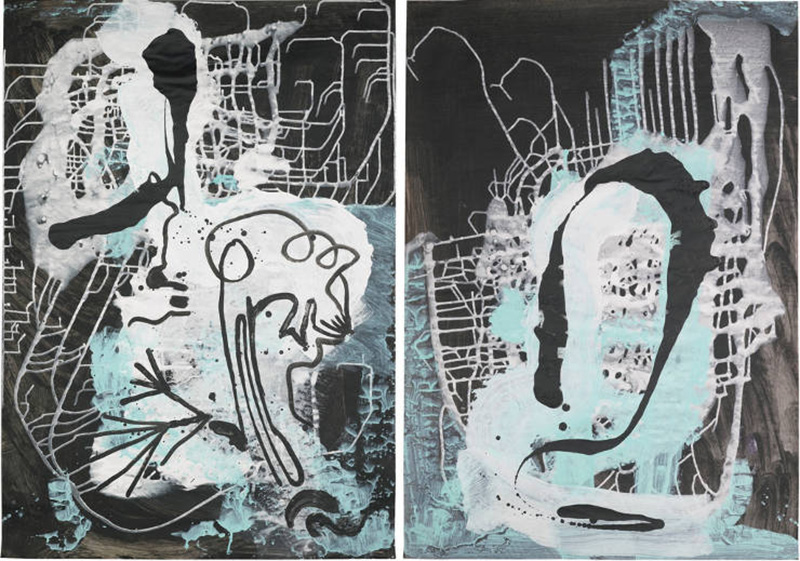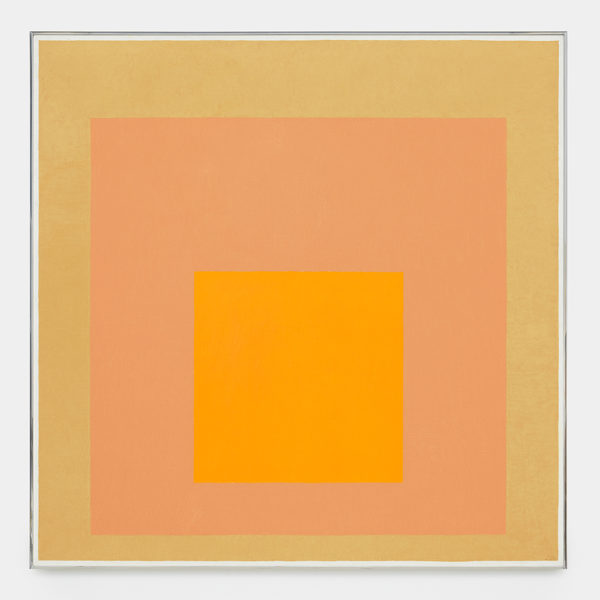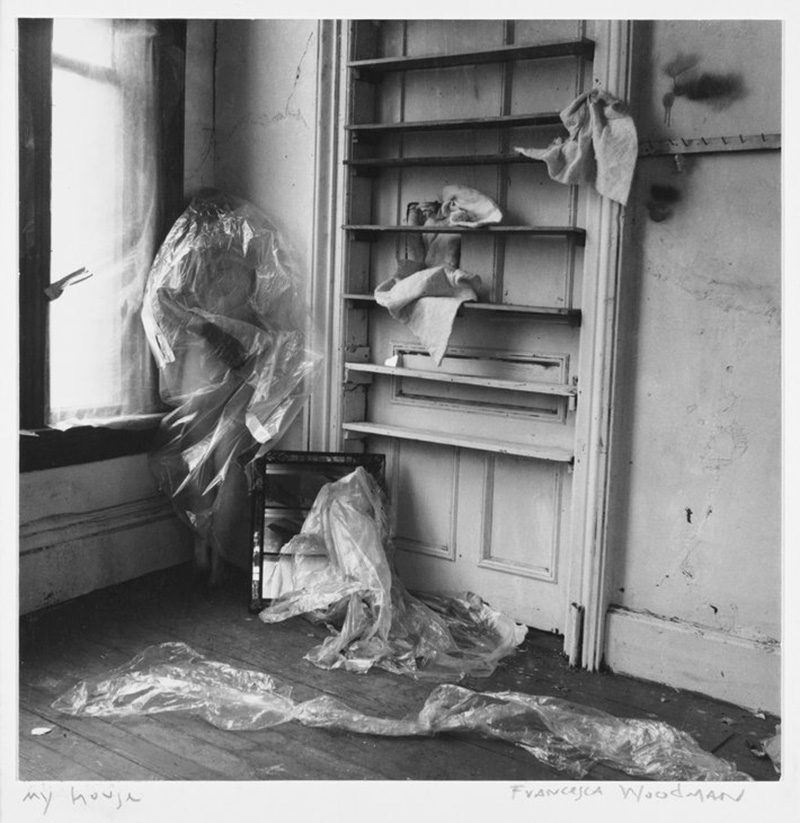ART CITIES:London-Openings
 Featuring over fifteen large-scale works on paper the exhibition “Pour Paintings” highlights the exuberant invention and uncommon beauty underlying Sigmar Polke’s work. His profoundly inventive output of paintings, objects, photographs and films challenged received notions around the role and meaning of art, making Polke one of the most important and influential figures of the post-war period. The transformative potential of materials, both physical and metaphorical, was Polke’s constant obsession in painting. His longstanding interest in alchemical practices led to deeper investigations of the optical effects of pigments and minerals in paint. A fascination with “higher powers” and an acceptance of the importance of accident within his practice also held special meaning for Polke. These material and conceptual interests brilliantly combine in the “Pour Paintings”, a group of mostly large-scale works on paper with which the artist was engaged over a period of roughly 15 years. The works are typified by evocative skeins of poured iridescent paint floating in a flat, void-like black ground and sometimes augmented with deliberate representational imagery. Powdered mica and other materials suspended in the viscous paint create illusions of shifting light and space, perceptions of which change depending on the viewer’s relation to the picture plane. As a discrete group of works, the works illustrate with surprising economy and elegance the key concerns of Polke’s aesthetic explorations. Info: Michael Werner Gallery, 22 Upper Brook Street, London, Duration: 13/1-4/3/17, Days & Hours: Tue-Sat 10:00-18:00, http://michaelwerner.com
Featuring over fifteen large-scale works on paper the exhibition “Pour Paintings” highlights the exuberant invention and uncommon beauty underlying Sigmar Polke’s work. His profoundly inventive output of paintings, objects, photographs and films challenged received notions around the role and meaning of art, making Polke one of the most important and influential figures of the post-war period. The transformative potential of materials, both physical and metaphorical, was Polke’s constant obsession in painting. His longstanding interest in alchemical practices led to deeper investigations of the optical effects of pigments and minerals in paint. A fascination with “higher powers” and an acceptance of the importance of accident within his practice also held special meaning for Polke. These material and conceptual interests brilliantly combine in the “Pour Paintings”, a group of mostly large-scale works on paper with which the artist was engaged over a period of roughly 15 years. The works are typified by evocative skeins of poured iridescent paint floating in a flat, void-like black ground and sometimes augmented with deliberate representational imagery. Powdered mica and other materials suspended in the viscous paint create illusions of shifting light and space, perceptions of which change depending on the viewer’s relation to the picture plane. As a discrete group of works, the works illustrate with surprising economy and elegance the key concerns of Polke’s aesthetic explorations. Info: Michael Werner Gallery, 22 Upper Brook Street, London, Duration: 13/1-4/3/17, Days & Hours: Tue-Sat 10:00-18:00, http://michaelwerner.com
 Josef Albers was instrumental in bringing the tenets of European modernism, particularly those associated with the Bauhaus, to U.S.A. His legacy as a teacher of artists, as well as his extensive theoretical work proposing that color, rather than form, is the primary medium of pictorial language, profoundly influenced the development of modern art in the United States during the ‘50s and ‘60s. In a new and unusual approach to color in the work Josef Albers, the exhibition “Sunny Side Up” at David Zwirner Gallery in London exhibition is devoted to Albers focuses on one color that held a pervasive place in the artist’s oeuvre. “Sunny Side Up”, a trove of paintings in which yellow dominates, is drawn from five decades of the artist’s work and conveys the limitless expressive potential of color and light that characterizes Albers’s practice as a whole. In the exhibition is on presention an extensive selection of the artist’s iconic “Homage to the Square” paintings, begun in 1950 and elaborated on until his death in 1976. Exploring a variety of chromatic and perceptual effects, the series serve as a sustained, serial investigation into rhythm, mood, and spatial movement within a carefully configured nested square format. By employing a variety of yellow tones in different combinations, Albers was able to play with perception and produce illusions of translucency. Also on view are paintings from Albers’s earlier “Variant/Adobe” series, which he initiated in 1947 in La Luz, New Mexico during a sabbatical from teaching at Black Mountain College. The abstract, architectonic forms that make up these works demonstrate the profound influence of Latin American art and culture on Albers’s practice. Info: David Zwirner Gallery, 24 Grafton Street, London, Duration: 13/1-10/3/17, Days & Hours: Tue-Sat 10:00-18:00, http://www.davidzwirner.com
Josef Albers was instrumental in bringing the tenets of European modernism, particularly those associated with the Bauhaus, to U.S.A. His legacy as a teacher of artists, as well as his extensive theoretical work proposing that color, rather than form, is the primary medium of pictorial language, profoundly influenced the development of modern art in the United States during the ‘50s and ‘60s. In a new and unusual approach to color in the work Josef Albers, the exhibition “Sunny Side Up” at David Zwirner Gallery in London exhibition is devoted to Albers focuses on one color that held a pervasive place in the artist’s oeuvre. “Sunny Side Up”, a trove of paintings in which yellow dominates, is drawn from five decades of the artist’s work and conveys the limitless expressive potential of color and light that characterizes Albers’s practice as a whole. In the exhibition is on presention an extensive selection of the artist’s iconic “Homage to the Square” paintings, begun in 1950 and elaborated on until his death in 1976. Exploring a variety of chromatic and perceptual effects, the series serve as a sustained, serial investigation into rhythm, mood, and spatial movement within a carefully configured nested square format. By employing a variety of yellow tones in different combinations, Albers was able to play with perception and produce illusions of translucency. Also on view are paintings from Albers’s earlier “Variant/Adobe” series, which he initiated in 1947 in La Luz, New Mexico during a sabbatical from teaching at Black Mountain College. The abstract, architectonic forms that make up these works demonstrate the profound influence of Latin American art and culture on Albers’s practice. Info: David Zwirner Gallery, 24 Grafton Street, London, Duration: 13/1-10/3/17, Days & Hours: Tue-Sat 10:00-18:00, http://www.davidzwirner.com
 The group exhibition “Room” at, Sadie Coles HQ in London brings together stand-alone installations and photographic works by: Louise Bourgeois, Beverly Buchanan, Heidi Bucher, Marvin Gaye Chetwynd, Rachel Feinstein, Nan Goldin, Klara Lidén, Hilary Lloyd, Sarah Lucas, Joanna Piotrowska, Penny Slinger, Andra Ursuta, Marianne Vitale, Francesca Woodman and Andrea Zittel. The exhibition reflects the multiple, often concurrent, roles of the room, whether as interior space or enclosing structure, as a metaphor for the psyche or a social construct and features artists who have envisaged the room as a psychological, erotically-charged space, as well as those who have explored the structural and aesthetic properties of the domestic unit. In many cases, the different attributes are inseparable: the room is at once a psychical and physical place. Andrea Zittel devised a different kind of personalised environment in her seminal series of “Escape Vehicles” (1996), each based on the cabin-like steel module of a mobile home. The version in the exhibition is a floatation tank – a hypothetical yet functioning survival capsule, complete with an underwater sound system, twin-spa light system, climate control and insulation. Marianne Vitale’s “Double Decker Outhouse” (2011) uses reclaimed lumber to form a closed and prisonlike entity, offsetting Minimalist aesthetics with sinister and absurdist undertones. In four series of photographic works by Nan Goldin, Joanna Piotrowska, Penny Slinger and Francesca Woodman, in which particular rooms have been frozen in time by the camera (a device which itself originated as a room: the sealed chamber of the camera obscura). For each of these artists, the real-life room becomes a mode of self-portraiture, an expression of memory, and a springboard for fantasies or follies. Info: Curator: Laura Lord, Sadie Coles HQ, 62 Kingly Street, London, Duration: 13/1-18/2/17, Days & Hours: Tue-Sat 11:00-18:00, www.sadiecoles.com
The group exhibition “Room” at, Sadie Coles HQ in London brings together stand-alone installations and photographic works by: Louise Bourgeois, Beverly Buchanan, Heidi Bucher, Marvin Gaye Chetwynd, Rachel Feinstein, Nan Goldin, Klara Lidén, Hilary Lloyd, Sarah Lucas, Joanna Piotrowska, Penny Slinger, Andra Ursuta, Marianne Vitale, Francesca Woodman and Andrea Zittel. The exhibition reflects the multiple, often concurrent, roles of the room, whether as interior space or enclosing structure, as a metaphor for the psyche or a social construct and features artists who have envisaged the room as a psychological, erotically-charged space, as well as those who have explored the structural and aesthetic properties of the domestic unit. In many cases, the different attributes are inseparable: the room is at once a psychical and physical place. Andrea Zittel devised a different kind of personalised environment in her seminal series of “Escape Vehicles” (1996), each based on the cabin-like steel module of a mobile home. The version in the exhibition is a floatation tank – a hypothetical yet functioning survival capsule, complete with an underwater sound system, twin-spa light system, climate control and insulation. Marianne Vitale’s “Double Decker Outhouse” (2011) uses reclaimed lumber to form a closed and prisonlike entity, offsetting Minimalist aesthetics with sinister and absurdist undertones. In four series of photographic works by Nan Goldin, Joanna Piotrowska, Penny Slinger and Francesca Woodman, in which particular rooms have been frozen in time by the camera (a device which itself originated as a room: the sealed chamber of the camera obscura). For each of these artists, the real-life room becomes a mode of self-portraiture, an expression of memory, and a springboard for fantasies or follies. Info: Curator: Laura Lord, Sadie Coles HQ, 62 Kingly Street, London, Duration: 13/1-18/2/17, Days & Hours: Tue-Sat 11:00-18:00, www.sadiecoles.com
